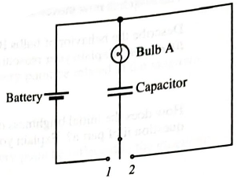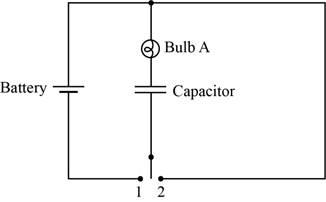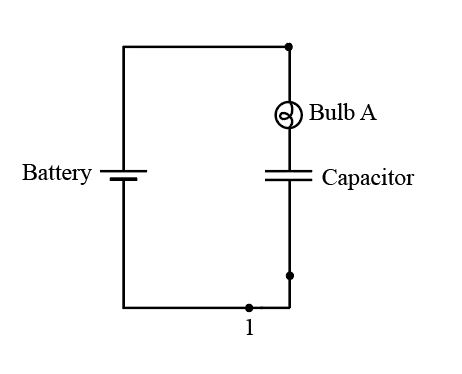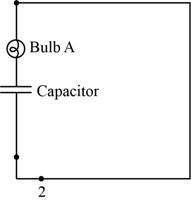
Describe the behavior of the bulb in the two situations below.

i. The switch is first moved to position 1. Describe the behavior of the bulb from just after the switch is closed until a long time later. Explain.
ii. The switch is now moved to position 2. Describe the behavior of the bulb from just after the switch is closed until a long time later. Explain your reasoning.
(i)
The behavior of the bulb from just after the switch is closed until a long time later in the situation when the switch is first moved to position
Explanation of Solution
Introduction:
Consider the circuit shown in Figure 1.

Figure 1
The brightness of the bulb depends upon the current flowing through that bulb. The bulb will be brighter if the flow of current through that bulb is high. In other words, more current passes through less resistance that mean if the resistance is less then bulb will appear brighter.
The circuit diagram when the switch is at position

Figure 2
Initially, thecapacitor is short circuited and starts charging slowly. As thecurrent decays with respect to time, the bulb initially glows, but later it goes dimmer with time, and after a long time it stops glowing.
If it stops glowing, the capacitor comes in the open circuit condition and the current flow across it is zero.
Conclusion:
Therefore, the behavior of the bulb from just after the switch is closed until a long time later is described above.
(ii)
The behavior of the bulb from just after the switch is closed until a long time later in the situation when the switch is now moved to position
Explanation of Solution
Introduction:
The brightness of the bulb depends upon the current flowing through that bulb. The bulb will be brighter if the flow of current through that bulb is high. In other words, more current passes through less resistance that mean if the resistance is less then bulb will appear brighter.
The circuit diagram when the switch is at position

Figure 3
The capacitor voltage is equal to battery voltage at the initial stage.After this, capacitor startsdischarging and the currentdecays with time. So, blub glows bright initially, but thengoes dimmer with time, and after long timeit stops glowing.
If it stops glowing, the capacitor comes in the open circuit condition and the current flow across it is zero.
Conclusion:
Therefore, the behavior of the bulb from just after the switch is closed until a long time later is described above.
Want to see more full solutions like this?
Chapter 20 Solutions
Tutorials in Introductory Physics
Additional Science Textbook Solutions
Microbiology: An Introduction
Anatomy & Physiology (6th Edition)
Applications and Investigations in Earth Science (9th Edition)
Biology: Life on Earth (11th Edition)
Campbell Biology (11th Edition)
Campbell Essential Biology with Physiology (5th Edition)
- 20. Two small conducting spheres are placed on top of insulating pads. The 3.7 × 10-10 C sphere is fixed whie the 3.0 × 107 C sphere, initially at rest, is free to move. The mass of each sphere is 0.09 kg. If the spheres are initially 0.10 m apart, how fast will the sphere be moving when they are 1.5 m apart?arrow_forwardpls help on allarrow_forwardpls help on thesearrow_forward
- pls help on all asked questions kindlyarrow_forwardpls help on all asked questions kindlyarrow_forward19. Mount Everest, Earth's highest mountain above sea level, has a peak of 8849 m above sea level. Assume that sea level defines the height of Earth's surface. (re = 6.38 × 106 m, ME = 5.98 × 1024 kg, G = 6.67 × 10 -11 Nm²/kg²) a. Calculate the strength of Earth's gravitational field at a point at the peak of Mount Everest. b. What is the ratio of the strength of Earth's gravitational field at a point 644416m below the surface of the Earth to a point at the top of Mount Everest? C. A tourist watching the sunrise on top of Mount Everest observes a satellite orbiting Earth at an altitude 3580 km above his position. Determine the speed of the satellite.arrow_forward
- pls help on allarrow_forwardpls help on allarrow_forward6. As the distance between two charges decreases, the magnitude of the electric potential energy of the two-charge system: a) Always increases b) Always decreases c) Increases if the charges have the same sign, decreases if they have the opposite signs d) Increases if the charges have the opposite sign, decreases if they have the same sign 7. To analyze the motion of an elastic collision between two charged particles we use conservation of & a) Energy, Velocity b) Momentum, Force c) Mass, Momentum d) Energy, Momentum e) Kinetic Energy, Potential Energyarrow_forward
 Glencoe Physics: Principles and Problems, Student...PhysicsISBN:9780078807213Author:Paul W. ZitzewitzPublisher:Glencoe/McGraw-Hill
Glencoe Physics: Principles and Problems, Student...PhysicsISBN:9780078807213Author:Paul W. ZitzewitzPublisher:Glencoe/McGraw-Hill University Physics Volume 1PhysicsISBN:9781938168277Author:William Moebs, Samuel J. Ling, Jeff SannyPublisher:OpenStax - Rice University
University Physics Volume 1PhysicsISBN:9781938168277Author:William Moebs, Samuel J. Ling, Jeff SannyPublisher:OpenStax - Rice University Physics for Scientists and EngineersPhysicsISBN:9781337553278Author:Raymond A. Serway, John W. JewettPublisher:Cengage Learning
Physics for Scientists and EngineersPhysicsISBN:9781337553278Author:Raymond A. Serway, John W. JewettPublisher:Cengage Learning Physics for Scientists and Engineers with Modern ...PhysicsISBN:9781337553292Author:Raymond A. Serway, John W. JewettPublisher:Cengage Learning
Physics for Scientists and Engineers with Modern ...PhysicsISBN:9781337553292Author:Raymond A. Serway, John W. JewettPublisher:Cengage Learning Physics for Scientists and Engineers: Foundations...PhysicsISBN:9781133939146Author:Katz, Debora M.Publisher:Cengage Learning
Physics for Scientists and Engineers: Foundations...PhysicsISBN:9781133939146Author:Katz, Debora M.Publisher:Cengage Learning





